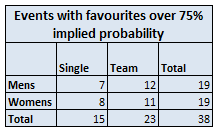Following on from yesterday’s discussion of Olympic “unbeatables”, here we will take another angle on Olympic favouritism by looking at the shortest price favourites at Rio.
Some events just won’t be competitive. In the table below, we have listed every event Sportsbet has a market for where the favourite is more than a 3 in 4 chance of winning:

Katie Ledecky’s dominance is astounding
We have also included in the above probabilities the chances of Katie Ledecky in winning two and three gold medals, just to illustrate the remarkable favouritism she enjoys (and perhaps the over-inflation of the available medal tally in the pool – perhaps more on that later.).
With two gold medals each a 98% probability, only three teams and zero individuals have a better implied chance of winning one gold medal than Ledecky does of winning two golds. Those teams are the New Zealand men’s coxless pair team and both Chinese table tennis teams. For an individual to look so dominant is pretty remarkable. For a 19-year-old it is genuinely astonishing – she is set up to dominate four or even five Olympics.
Teams are more dominant
A majority of the shortest price favourites on this list are teams of athletes rather than individuals. Team events seem to lend themselves to overwhelming favouritism more readily, presumably because while a single athlete can get sick get disqualified or have a bad day, the chances of a whole team messing up are substantially lower.
The team events lend themselves especially well to dominance by the biggest countries, which have large populations with deep talent pools that are best leveraged when an event requires a lot of athletes. 8 American teams and 7 Chinese teams loom as unbackable (15 of the 23 team events), while Great Britain and New Zealand are the only other countries with multiple teams in the list.
Rowing is a solved game
Rowing events feature heavily in this list with 6 entries, nearly as many as Athletics (7) and Swimming (9) and both of those have many more total medals on offer – 32 for Swimming and 47 for Athletics vs 14 for Rowing.
Only Basketball (2 of 2), Table Tennis (2 of 4) and Diving (4 of 8), and Soccer (1 of 2) have a higher share of all their events in this list.
In Rowing, the small fields, predominance of team events, lack of interaction between competitors and lack of randomness all lend themselves to a great deal of certainty about the result of many events. A strong cross-wind impacting some of the field more than others might be the only major external factor to influence the event, but the clusteredness of favourites in adjoining lanes mitigates even this.
Genders roughly evenly represented among dominant favourites
There is some conjecture that many womens events should have shallower fields due to lower global sport participation rates, and thus be easier to dominate for an outstanding athlete. This is plausible – there are a lot of cultural, social and economic barriers to women entering and remaining in competitive sport throughout most of the world. However, in these games we don’t see that in the dominant favourites, which are about evenly split by gender. There’s an extra single woman competitor (really the same woman twice) in the list and an extra male team:
